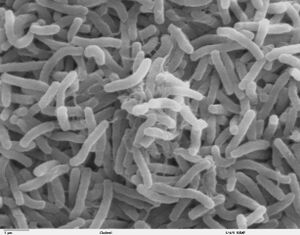Vibrio
Template:Infobox - bakterie The genus Vibrio belongs to the family Vibrionaceae, which includes the genera Vibrio and Photobacterium.[1] They are facultatively anaerobic gram-negative curved rods belonging to non-sporulating bacteria. It differs from the Enterobacteriaceae family by the polar location of the flagella and the positive oxidase reaction.[1]
Basic characteristics[edit | edit source]
All species are motile and use a flagellum to move. Due to its rapid movement, this genus was named Vibrio. They have fermentative and respiratory metabolism. Some species, such as Vibrio fischeri, are capable of bioluminescence due to the enzyme luciferase, causing the so-called fluorescence of the sea. They live mainly in tropical and subtropical areas, freely in salt water, but we can also find them in fresh water, or in coexistence with marine animals, where they act as symbionts, but also as parasites. They are most often found in ports. Vibrios are also often human pathogens. These include, for example, V. cholerae, V. parahaemolyticus and V. vulnificus. The infection usually occurs after ingestion of undercooked seafood, especially oysters, or after ingestion of contaminated water, which can result in gastroenteritis or general sepsis. Transmission is also possible from person to person via the fecal-oral route. Wild pathogenic vibrios can enter open wounds and cause an inflammatory reaction.
Vibrio cholerae[edit | edit source]
Vibrio cholerae is the most important species of the genus Vibrio. We divide the species V. cholerae into two groups. Serotypes O1 and O139 belong to the first group, they produce cholera toxin and cause cholera. We also divide the El Tor strain from the V. cholerae O1 group. We classify all other strains in the second group and call them non-O1 / non-O139 serotypes. Some of them also produce toxins and occasionally cause diarrheal diseases.
Links[edit | edit source]
Related articles[edit | edit source]
- Gram staining
- Cholera
- Infection with so-called non-cholera vibrations
- Diarrheal diseases : Viral gastroenteritis ▪ Bacterial gastroenteritis ▪ Gastrointestinal parasitosis ▪ Enterotoxicosis ▪ Drug-induced diarrhea ▪ Differential diagnosis of diarrheal diseases ▪ Treatment of diarrheal diseases
References[edit | edit source]
[1]Literature[edit | edit source]
- MURRAY, Patrick R – ROSENTHAL, Ken S. Medical microbiology. 6. edition. Philadelphia : Mosby, 2009. pp. 317-320. ISBN 978-0-323-05470-6.
- PRESCOTT, Lansing M – HARLEY, John P. Microbiology. 3. edition. Dubuque : Wm. C. Brown, cop. 1996. pp. 427-429. ISBN 0-697-21863-5.
- ↑ BENEŠ, Jiří, et al. Infectious medicine. 1st edition. Galén, 2009. 651 pp. 246-249. ISBN 978-80-7262-644-1 .

